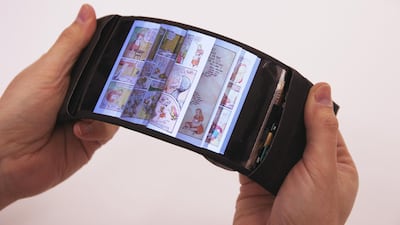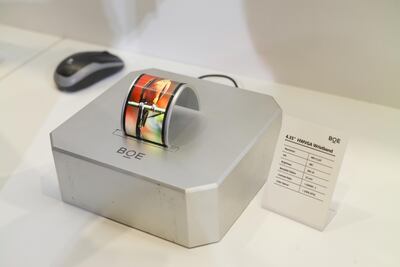Over the years, countless science fiction films and TV shows have boldly predicted that digital screens of the future will come in all shapes and sizes, from curved billboards to foldable newspapers. It's become a staple sci-fi ingredient. In these futuristic realms, literally any surface can become a screen capable of displaying sleek, moving high-resolution images. In 2018, we're still living in a predominantly flat-screen world, but the technology powering flexible, bendable displays is developing fast, and has almost been hiding in plain sight. If you own an iPhone X or one of the Samsung Edge smartphones, you'll already be using a flexible display – albeit one imprisoned behind a sheet of glass. Now such displays are getting ready to shed their cases, show off their curves, and bend and flex. The firms developing them, meanwhile, are hoping this is something we find alluring.
The most dramatic manifestation of this technology has been created by a Chinese firm called Royole, which this week has been exhibiting at the IFA Conference in Berlin, an annual showcase of consumer electronics. Their phones' ultra-thin, flexible, full-colour screens have been incorporated into top hats and T-shirts, which they're currently selling on their website for around Dh7,500. Watching video footage playing on someone's chest is a neat way of demonstrating how flexible such screens can be – but these gimmicks are just the beginning.
"As I travel about, I see all kinds of surfaces around me and imagine them as screens," says Paul Cain, strategy director at flexible-electronics firm FlexEnable. "It's an occupational hazard. We're all so used to having glass screens in our lives that we assume that's just how it is – but our work is about bringing everyday surfaces to life. It's a huge aesthetic opportunity."
How has this opportunity arisen? The organic light-emitting diodes (OLEDs) in these displays emit their own light, and as a result they don't need a backlight. This means they can be affixed to thin, lightweight materials, including plastic. As the performance and efficiency of these OLEDs improved over the last decade, giants of the technology industry such as LG, Apple, Samsung and Sony have trialled their own flexible display technology. Way back in 2010, Sony announced they had developed a full colour, 4.1-inch OLED display, as thin as a human hair and rollable into a tube, while Samsung's flexible OLEDs have been around for more than five years. But the idea of screens that actually bend still feels very futuristic to consumers. At this year's CES show in Las Vegas, LG wowed people with a demonstration of a 65-inch TV that rolled up – essentially the same trick as Sony 8 years earlier, but 15 times bigger. So if the technology has been around for so long, why are so few products showing it off to its full potential?
"Twenty or so companies have made prototypes over the years," says Cain, "but there's a difference between a demo and a mass production process.
“The challenge [with flexible displays] is that you’re often using new materials and new processes at the same time, and that’s obviously a lot of innovation on separate fronts that has to all come together.”
The most obvious problem with creating a multifunction device (such as a tablet) that has a flexible screen is that it's not just the display that needs to flex. All the other components have to flex too and some of those – particularly batteries – present extreme challenges to designers and engineers. But some companies are rising to those challenges. A technology conference in Los Angeles back in May saw Chinese firm BOE showcase a smartphone with a 5.5-inch bendable screen.
Now, it would be perfectly reasonable for anyone reading this to ask: "Why would I want my smartphone to bend anyway?" – but Cain believes the advantages of flexible displays will make themselves apparent in more subtle ways.
The first is durability. Modern devices with glass screens are inherently fragile, while the natural "give" of plastic screens makes them far less susceptible to damage. "Then there are applications where the weight alone brings a benefit," Cain says. "If airlines replaced each of the seat-mounted screens in an aircraft with plastic screens, they'd save about US$400 (Dh1,469) per seat in fuel over the life of the entertainment system. And you can wrap a screen around a surface. They can have curved edges, and holes. Think of a car dashboard; these days, aside from the vanity mirror, the screen is pretty much the only flat surface left in a car. Everything else is curved and flowing. Why would you design a car around a display, when you can design a display around a car?"
The car dashboard may be the perfect application for flexible screen technology, but in the past couple of months there have been a number of announcements from smartphone manufacturers suggesting new devices may be in the pipeline.
In July, Samsung announced it had developed an fortified plastic OLED panel certified as "unbreakable", after it had been subjected to US military-standard durability tests.
In addition, there's speculation that its long-awaited foldable smartphone, the Galaxy X, may appear soon. "Not far away" was the assessment of DJ Koh, the firm's head of mobile business, at a news conference last month. LG, Huawei and Lenovo-Motorola have also been making noises about foldable phones – and this almost seems to herald the rebirth of the clamshell-style phone you would snap open and shut several times a day.
These days, of course, we’ve become used to devices being flat. How appealing will consumers find the idea of folding their devices in half, making them half the size but twice the thickness?
Well, by this time next year, smartphone manufacturers may be in a position to start finding out.
_____________________
Read more:
Our batteries are stronger than ever. Trouble is, they still sometimes explode
How face filters on phone apps are leading teens to get plastic surgery
Dislike: why the thumbs down option on Facebook is a fundamentally flawed idea
_____________________


